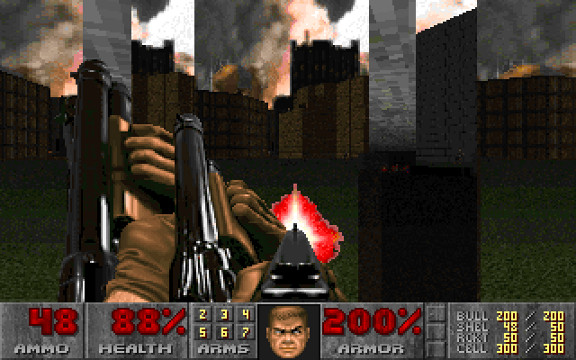
My video card has always been finicky. Mostly just the occasional, barely-noticeable pink lines dancing in the title bars of windows. (I had to look up what that very top bit of a window is called.) A little unnerving, but nothing serious. It served me admirably for years, despite being a touch eccentric. We were a good fit. I can appreciate eccentric.
Last weekend, though, it took things to a whole new level. Where we’d had minor glitches before, we were now in full-blown catastrophic failure territory. The problem began with Borderlands 2, which froze up with garbled graphics and required a system restart. Weird, but probably not something serious. On the second, third, fourth tries, though, the game was frozen solid almost instantly.
Must be an overheating issue. The card didn’t feel all that hot when I took it out, but what the heck; I figured I’d apply some fresh thermal paste to see if that made any difference.
It did.

An easy fix definitely wasn’t in the cards. I ordered a replacement immediately, but that meant I had to make do with my computer in its current state for at least a few days. It was not easy on the eyes staring at this for hours on end:

It did make me think, though. On top of being an annoyance, for me a glitch has always been both beautiful and terrifying. Beautiful because, hey — I can’t deny that the Windows loading screen above is quite lovely in a very modern art sort of way. Terrifying because this is a system that I know like the back of my hand. I know the ins and outs and I understand how it should work. When it doesn’t work that way, all expectation and reason is thrown out the window.
I’ve interacted with computers about as much as I’ve interacted with the world outside. When my computer stops obeying the rules that govern it, you might as well be telling me that the laws of physics no longer apply. My world is upside-down. Dogs and cats are living together.
I grew up so connected to a computer that it feels like part of my body, and when a part of my body starts malfunctioning, I don’t take it lightly. To make things worse, this extra body part isn’t just a limb — an arm or a leg — it’s a sensory organ. I see the world through it. It’s my connection to friends and to information.
For a computer person — at least one in his youth, who has only his one computer and is totally at the mercy of adults to get it fixed — a serious glitch is our version of the eye scream.
That’s how I felt years ago, at least. The fears were real. It goes all the way back to my NES days, popping in a cartridge and seeing that glitched-out opening screen. You get used to it after a while; you learn to pull the game back out, blow in the end (did that really accomplish anything?), slide it back in, maybe wiggle it around, and finally it would work again. But before you get used to it — before it becomes ordinary — it’s quite frightening. It’s like some bizarre body horror, seeing a game you know so well warped and freakishly deformed. This is something that shouldn’t be happening. This is something I was never intended to see.
It’s that fear of the unknown again: the strange and unnatural. But there’s also wonder and beauty to be found. The older I get, the more fascinated I become with bugs in games, or the remnants of cut content, or experiences completely outside of what the creators intended.
Take the door glitch in Metroid, which allowed you to pass outside the intended game area and into uncharted realms of weirdness. Or this eerie island in Goldeneye 007, barely visible from across the water, a phantom left over from a cut mission objective. Even the visually abrasive hall of mirrors effect in Doom when the player cheats and leaves the confines of the level.

During my now-regrettable stint playing World of Warcraft, one of my greatest joys was in exploration, and there were plenty of areas I found that I’m sure I wasn’t supposed to. I swam all around the coast of the Northern Kingdoms, past and through where Eversong Woods supposedly was (all that was really there was a huge expanse of ocean). I discovered that if you set out in the right direction from the Echo Isles, it was possible to swim all the way to the edge of the world, where the ocean ended in a jagged wall of earth and, beyond that — literally nothing. Though I never explored them myself, I’m endlessly fascinated by stories and videos of players who have reached Old Ironforge or climbed to the airstrip above the city.
When we find those places, even the layman like me can see the seams left over from the creation of these systems. Even if we understood that the constructed world had to end somewhere, now we see where it ends and what is beyond. We see beyond the system, outside its artificial world, and we catch a glimpse of the hands that shaped it. We touch what is, from our vantage point within the virtual world, God.
I can’t put the emotion I feel upon finding these glitches into a single word. Certainly, it is a mix of both fear and wonder. It’s humbling and inspiring, too, in the same moment. Maybe it’s in part a need as human beings to rebel against confinement — a compulsion, even while we willingly place ourselves into an artificial system of rules and boundaries, to break those rules. The desire to know what makes everything tick. Whatever emotion it is, I’m confident at least that I’m not the only person who feels this way. Jonas Kyratzes tapped into it brilliantly with his game Alphaland.
All I can say is that the glitch is magical, both in an aesthetic sense and in terms of what it represents.
Maybe an example from outside the sphere of gaming would better convey the sense of beauty I’m talking about. I’ll leave you with something I caught on Shamus Young’s blog a few months back that plays with a similar concept, but in the realm of digital video rather than videogames.
I grew up with the complex paper wargames of the 1970s as my pinnacle of gaming. They offered a different experience, because in 99% of them you had all the information and structure immediately before you. Part of the gaming experience was understanding how the game was put together, how it was supposed to translate history into the game. It was a different type of experience. The glitches of that era were in the rules, and when you have rules books that easily ran 12 pages, there were a lot of opportunities for glitches. It became another game in itself for us players, who would send in questions to the publisher, who would answer them and/or publish errata. Meanwhile, you’d adopt the rule that made the most sense, based on the game, if you could figure out one.
I hadn’t really thought about that particular change in the gaming experience with the advent of computer games. Thanks.
Hi. I am visiting your post after visiting the LPalmer Chronicles. It’s been quite an eye-opener. When I was reading about your video card problems, I thought you were talking about your membership card for the video shop at first. Obviously, it has been a long day. Who hires videos anymore? You would probably be shocked to find out that I work for an IT company but I’m in marketing. I can barely turn on our own TV. Despite my poor technical aptitude, the kids and my husband are trying to teach me Minecraft Meanwhile, I’m teaching them the violin.
Oh! How are you liking Minecraft so far? I’ve often wondered whether it was a good game to use in introducing someone to videogames. It’s relatively simple in concept but it’s also sort of this amophous, shapeless experience with no real goal until you impose one from the outside. I can see the undirectedness turning some people off.
I’m glad you were able to fix your computer glitch. It looks a bit like the re-mix version of your screen, though.